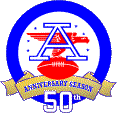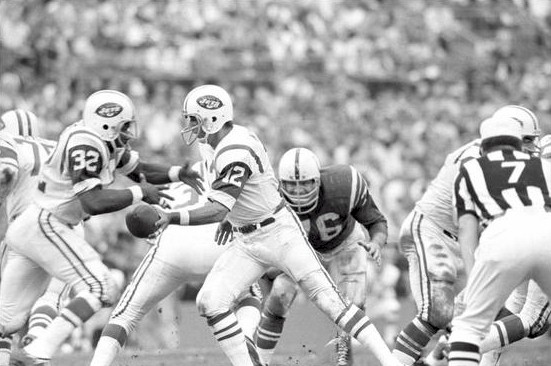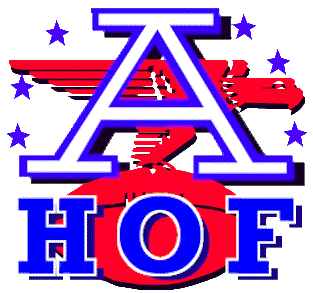By ALLEN BARRA
The American Football League, the
most exciting and innovative league in
American sports history, is remembered
today for something that happened near
the end of its 10-year life.
On Jan. 12, 1969, Joe Namath, the
$400,000 quarterback actually, he was
signed by New York Jets owner Sonny
Werblin for a shocking $427,000 out of
the University of Alabama in 1965 led
the New York Jets to what many still
regard as the biggest upset in
pro-football history, a 16-7 win over
the mighty Baltimore Colts. The
spectacular victory legitimatized the
hopes and dreams of the upstart AFL. A
year later, the league was gone.
"The National Football League finally decided it couldn't beat the American Football League," says former New York Giants general manager Ernie Accorsi, "so it absorbed them."
By the time the 1970 season began, the two leagues had merged; the newly designed NFL was divided into two conferences, the NFC (consisting of 13 original NFL teams) and the AFC (the AFL teams plus three franchises that were already part of the NFL the Pittsburgh Steelers, Cleveland Browns and Baltimore Colts).
"The NFL was there first," says Bob Costas, "and it had the most teams, but you can make the case that the genesis of modern professional football was the AFL."
It was the AFL that first used the two-point conversion in the pro game, posted the official time on the scoreboard clock, put the players' names on their jerseys, introduced soccer-style professional place kickers and perfected the creative wide-open offenses. The NFL had a head start of nearly four decades, but it was the AFL that dragged it, kicking and screaming, into the 1960s.
This Wednesday, the first installment of "Full Color Football: The History of the American Football League" premieres on Showtime at 8 p.m. EDT. Produced by NFL Films, the five-part series covers the AFL from the moment Texas oilman Lamar Hunt first conceived of the idea of a new league in 1959 to its second and final championship game after the 1969 season. (The first NFL championship was played in January, 1967 after the 1966 season; Lombardi's Green Bay Packers won the first two, the AFL won the last two.)
"Full Color Football" is the first production by NFL Films taken largely from footage not originally shot by the company. "We used some old surviving AFL clips, some local TV broadcasts and movies shot by the teams themselves," says president Steve Sabol. "It's amazing, but there's no documentary history of the league. This is as close as it's going to come."
In contrast to the older, established league the one with Mount Rushmore-like authority figures George Halas of the Chicago Bears, Paul Brown of the Cleveland Browns and Vince Lombardi of the Green Bay Packers AFL owners and coaches were colorful and positively nonconformist. "You could say that three people symbolized the dynamics of the AFL in the 1960s: the Oakland Raiders' Al Davis, the New York Jets' Sonny Werblin and Kansas City Chiefs coach Hank Stram," says Paul Camarata, senior producer of "Full Color Football." "They were all flamboyant, outspoken and understood the value of show business in football."
Stram, in particular, became a fan favorite with his garish red vests and pasted-down toupees. "He was the first coach," says Mr. Sabol, "to win a championship while wearing a suit and toupee made of the same material." A devotee of "Star Trek," Stram captured the imagination of fans by adapting the Vulcan philosophy of Mr. Spock to football. He once told reporters he believed in "infinite diversity in infinite combinations."
The AFL's own diversity wasn't quite infinite, but it brought professional football to cities that the NFL had snubbed. While the NFL establishment fumed, the AFL expanded its roster to include the Houston Oilers (now the Tennessee Titans), Dallas Texans (soon to be the Kansas City Chiefs), Los Angeles Chargers (who would move a few miles south to San Diego), Oakland Raiders, Buffalo Bills, Miami Dolphins, Boston Patriots (now New England), New York Titans (renamed the Jets), Cincinnati Bengals and Denver Broncos. NFL owners who waged war against the AFL for nearly a decade found that by the late 1960s they were joining forces with a league that had done them a huge favor by broadening the television market and nearly doubling their value in television revenues.
The AFL's and Stram's greatest triumph was the league's last game. On Jan. 11, 1970, in the fourth and final meeting between the two leagues' champions and the second game to officially use the name "Super Bowl," Stram's Kansas City Chiefs, a 16-point underdog, thrashed the Minnesota Vikings 23-7. "It's a triumph that most fans don't remember today," says "Full Color Football" co-producer David Plaut, "even though it might have been a greater victory than the Jets over the Colts the year before. A lot of people still thought the Jets' victory was an aberration and that the NFL dominance would reassert itself. But the Chiefs absolutely dazzled them with tactics and plays no NFL team would have used, like the unbalanced defensive line and the end around. The Vikings had their great defensive line, 'The Purple People Eaters,' but they were never in that game. Kansas City beat them physically, mentally and emotionally." The fifth episode in "Full Color Football" brings that game to life for a new generation of fans, with the kinetic Stram striding up and down his team's sideline shouting "pump it up, baby pump it up! Keep matriculatin' that ball!"
That Chiefs team, says Mr. Camarata, "was the culmination of just about all the significant developments in pro football that decade. For one thing, it was the first pro-football team with a majority of African-American players. Like most of the top AFL teams, Kansas City had done their homework, searching out players from small colleges." Simply put, they found new places to look for talent small colleges and historically black colleges.
Like Stram said, infinite diversity in infinite combinations.
—Mr. Barra writes about sports for the Journal.




